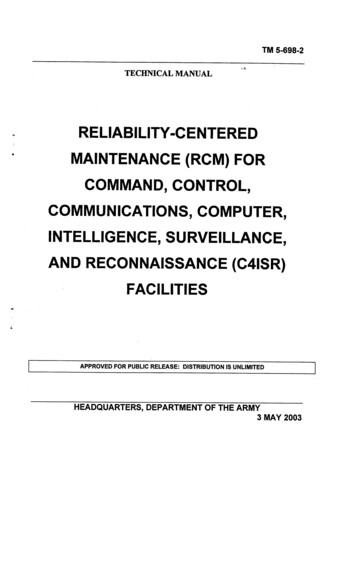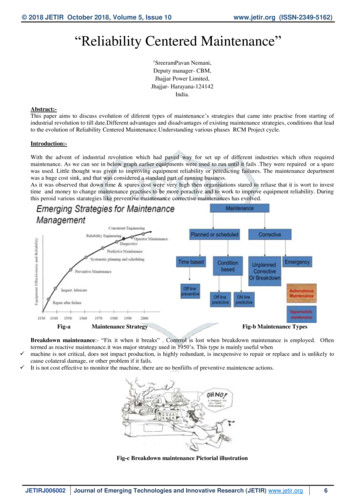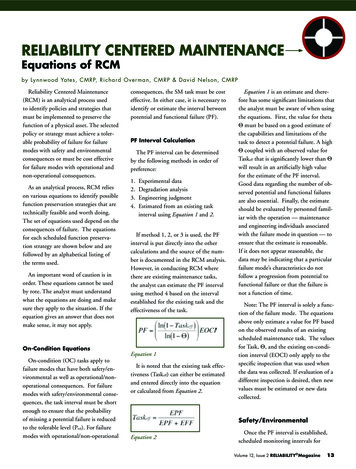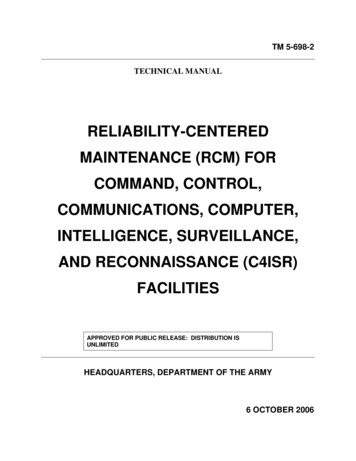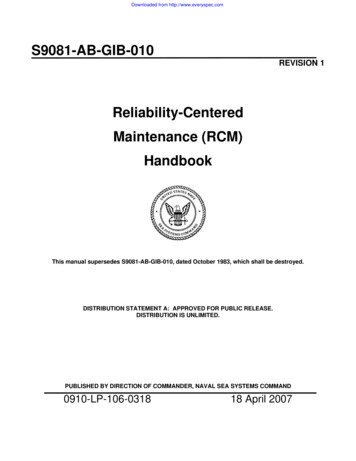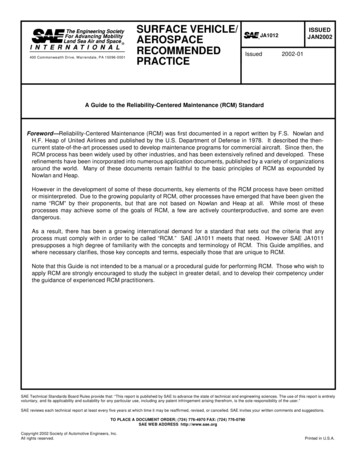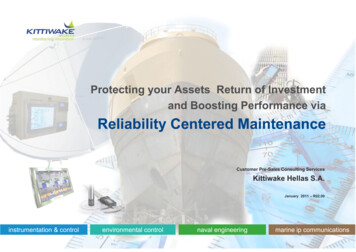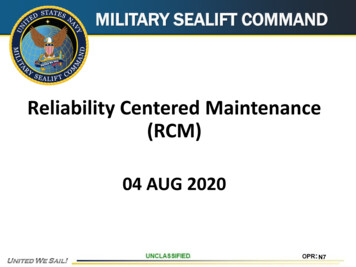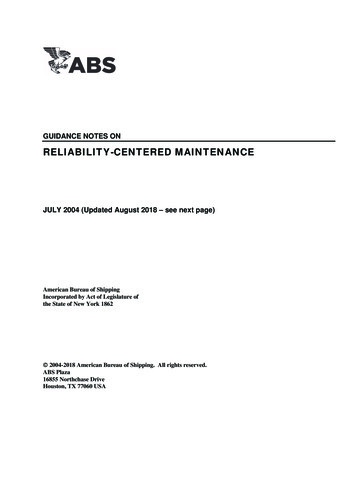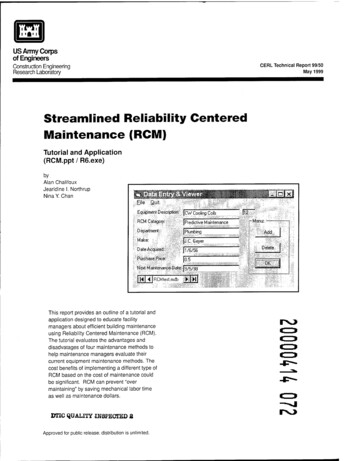
Transcription
US Army Corpsof EngineersCERL Technical Report 99/50May 1999Construction EngineeringResearch LaboratoryStreamlined Reliability CenteredMaintenance (RCM)Tutorial and Application(RCM.ppt / R6.exe)byAlan ChalifouxJearldine I. NorthrupNinaY Chanfife" ""Quit;Equipment Description: CW Cooling Coilsi.RCM Category:Department:[Maker ;;:Predictive Maintenance(Plumbingw.;Date AcquiredPurchase Price:This report provides an outline of a tutorial andapplication designed to educate facilitymanagers about efficient building maintenanceusing Reliability Centered Maintenance (RCM).The tutorial evaluates the advantages anddisadvatages of four maintenance methods tohelp maintenance managers evaluate theircurrent equipment maintenance methods. Thecost benefits of implementing a different type ofRCM based on the cost of maintenance couldbe significant. RCM can prevent "overmaintaining" by saving mechanical labor timeas well as maintenance dollars.DTIC QUALITY INSPECTED 2Approved for public release; distribution is unlimited.Add; J.C. Geyer11/6/560.5H xÄäint#«nii.!lä lj 9/5/98llJ jRCMtestmdb tea. n\ DelÄtasOK
The contents of this report are not to be used for advertising, publication,or promotional purposes. Citation of trade names does not constitute anofficial endorsement or approval of the use of such commercial products.The findings of this report are not to be construed as an officialDepartment of the Army position, unless so designated by other authorizeddocuments.DESTROY THIS REPORT WHEN IT IS NO LONGER NEEDEDDO NOT RETURN IT TO THE ORIGINATOR
USER EVALUATION OF REPORTREFERENCE: USACERL Technical Report 99/50, Streamlined Reliability Centered Maintenance(RCM): Tutorial and Application (RCM.ppt /R6.exe)Please take a few minutes to answer the questions below, tear out this sheet, and return it to USACERL.As user of this report, your customer comments will provide USACERL with information essential forimproving future reports.1.Does this report satisfy a need? (Comment on purpose, related project, or other area of interest forwhich report will be used.)2.How, specifically, is the report being used? (Information source, design data or procedure,management procedure, source of ideas, etc.)3.Has the information in this report led to any quantitative savings as far as manhours/contract dollarssaved, operating costs avoided, efficiencies achieved, etc.? If so, please elaborate.4.What is your evaluation of this report in the following areas?a. Presentation:b. Completeness:c. Easy to Understand:d. Easy to Implement:e. Adequate Reference Material:f. Relates to Area of Interest:g. Did the report meet your expectations?"
h. Does the report raise unanswered questions?General Comments. (Indicate what you think should be changed to make this report and futurereports of this type more responsive to your needs, more usable, improve readability, etc.)5. If you would like to be contacted by the personnel who prepared this report to raise specific questionsor discuss the topic, please fill in the following information.Name:Telephone Number:Organization Address:6. Please mail the completed form to:Department of the ArmyCONSTRUCTION ENGINEERING RESEARCH LABORATORYATTN: CECER-IM-TP.O. Box 9005Champaign, IL 61826-9005
Form ApprovedOMB No. 0704-0188REPORT DOCUMENTATION PAGEPublic reporting burden tor this collection of information is estimated to average 1 hour per response, including the time for reviewing instructions, searching existing data sources,gathering and maintaining the data needed, and completing and reviewing the collection of information. Send comments regarding this burden estimate or any other aspect of thiscollection of Information, including suggestions for reducing this burden, to Washington Headquarters Services, Directorate for information Operations and Reports, 1215 JeffersonDavis Highway, Suite 1204, Arlington, VA 22202-4302, and to the Office of Management and Budget, Paperwork Reduction Project (0704-0188), Washington, DC 20503.1.AGENCY USE ONLY (Leave Blank)2. REPORT DATE3. REPORT TYPE AND DATES COVEREDFinalMay 19994.5.TITLE AND SUBTITLEStreamlined Reliability Centered Maintenance (RCM): Tutorial and Application(RCM.ppt / R6.exe)6.FUNDING NUMBERS4A162720D048U58AUTHOR(S)Alan Chalifoux, Jearldine I. Northrup, and Nina Y. Chan7.8.PERFORMING ORGANIZATION NAME(S) AND ADDRESS(ES)U.S. Army Construction Engineering Research Laboratory (CERL)P.O. Box 9005Champaign, IL 61826-90059.TR 99/5010. SPONSORING / MONITORINGAGENCY REPORT NUMBERSPONSORING / MONITORING AGENCY NAME(S) AND ADDRESS(ES)Madigan Army Medical CenterATTN: MAMC-FMDDepartment of EngineeringTacoma,WA 984319.PEFORMING ORGANIZATIONREPORT NUMBERSUPPLEMENTARY NOTESCopies are available from the National Technical Information Service, 5385 Port Royal Road, Springfield, VA 2216112b. DISTRIBUTION CODE12a. DISTRIBUTION / AVAILABILITY STATEMENTApproved for public release; distribution is unlimited.13. ABSTRACT (Maximum 200 words)This report provides an outline of a tutorial and application designed to educate facility managers about efficient buildingmaintenance using Reliability Centered Maintenance (RCM). The tutorial evaluates the advantages and disadvatages of fourmaintenance methods to help maintenance managers evaluate their current equipment maintenance methods. The costbenefits of implementing a different type of RCM based on the cost of maintenance could be significant. RCM can prevent"over maintaining" by saving mechanical labor time as well as maintenance dollars.15. NUMBER OF PAGES14. SUBJECT TERMS24facility managementcost effectivenessmaintenance and repair17. SECURITY CLASSIFICATIONOF REPORTUnclassifiedNSN 7540-01-280-550016. PRICE CODE18. SECURITY CLASSIFICATIONOF THIS PAGEUnclassified19. SECURITY CLASSIFICATIONOF ASTRACTUnclassified20. LIMITATION OFABSTRACTSARStandar d Form 298 (Rev. 2-89)Prescribed by ANSI Std 239-18298-102
CERL TR 99/50ForewordThis study was conducted for Madigan Army Medical Center under Project4A162720D048, "Industrial Operations Pollution Control Technology," Work UnitU58, "Enhanced O&M of Pollution Control Equipment." The technical monitorwas Michael Carico, MAMC-FMD.The work was performed by the Environmental Processes Branch (CN-E), of theInstallations Division (CN), U.S. Army Construction Engineering ResearchLaboratory (CERL). The CERL principal investigator was Jearldine I. Northrup.Mark W. Slaughter is Chief, CECER-CN-E and Dr. John T. Bandy is Chief,CECER-CN. The CERL technical editor was William J. Wolfe, InformationTechnology Laboratory.Dr. Michael J. O'Connor is Director of CERL.
CERL TR 99/50ContentsSF2981 achMode of Technology Transfer66Categories of Reliability Centered Maintenance (RCM)723Run-to-Faiiure7Preventive Maintenance (PM)7Predictive Maintenance (PDM)8Proactive Maintenance (PAM)8Reliability Centered Maintenance (RCM) Program10Overview of Tutorial1Overview of Application140References1ßAppendix A: Referenced Screen Shots17Appendix B: Setup21Distribution
CERL TR 99/50List of FiguresFigures1Advantages and disadvantages of each type of maintenance112RCM logic tree123Laser alignment134Launch RCM application from RCM exercise135Message boxes guide the user through the program146Pull down menus157Data entry form15A1 Overview of tutorial17A2 General questions for each type of RCM17A3 RCM tree18A4 RCM categories definition box18A5 Preventive maintenance costs calculator19A6 Predictive maintenance costs calculator19A7 The program guide's pop-up boxes will offer an explanation of RCM type20
CERL TR 99/501 IntroductionBackgroundReliability Centered Maintenance (RCM) was a maintenance concept developedin the airline industry during the late 1960s. Keeping a fleet of aircraft inservice is a maintenance-intensive effort. Performing preventive maintenance(PM) on the fleets took many resources. Airline companies wanted to see if theycould maintain their fleets at the same level of quality at a lower cost. A strongcorrelation between age and failure rate did not exist. This indicated that timebased PM was inefficient for the majority of equipment.A new RCM program incurs an initial investment to obtain technological tools,training, and equipment condition baselines.This initial increase inmaintenance costs due to RCM is short-lived. The cost of reactive maintenancedecreases because failures are prevented and condition monitoring (CM) replacespreventive maintenance tasks. This results in a reduction in both reactivemaintenance and total maintenance costs. Energy savings may also be expectedfrom the use of CM that is part of any RCM program. A further cost savingsfrom adopting RCM is that the program obtains the maximum use fromequipment. RCM allows maintenance managers to replace equipment based, noton calendar, but on actual equipment condition. This condition approach tomaintenance extends the lives of both the facility and its equipment. Eventhough maintenance only accounts for a relatively small portion of the overalllife cycle costs of a facility, a balanced RCM program can achieve savings of 30 to50 percent in a facility's annual maintenance budget.In addition to PM, RCM recognizes other maintenance strategies including runto-failure, predictive maintenance, and proactive maintenance.Eachmaintenance strategy suits a different equipment type. This project wasundertaken to provide Army installations the capability to select the appropriatemaintenance strategy from RCM in specific situations to maintain its equipmentand optimize production and services.
CERL TR 99/50ObjectivesThe objectives of this study were to:1. Examine the principles of RCM as a means of optimizing maintenance activitiesand minimizing degraded performance or failure.2. Prepare a "primer" to teach novices and to give experienced facilitiesmaintenance staff members a "refresher course" in the principles of RCM.3. Create a tutorial application that could help evaluate whether the maintenancebeing performed on a piece of equipment was correct.ApproachEach of the various maintenance strategies included in RCM is individuallysuited for specific pieces of equipment. The different maintenance strategieswere approached and their advantages and disadvantages documented. AnRCM logic tree was constructed to help a maintenance manager to select theappropriate maintenance strategy for a particular piece of equipment.Mode of Technology TransferThe RCM Tutorial and Application will be available on the CERL web page:http://www.cecer.army.mil/
CERL TR 99/502 Categories of Reliability CenteredMaintenance (RCM)RCM recognizes the value of your personnel and takes advantage of theirextensive experience running the facility/equipment. Run to Failure (RTF) works on the assumption that it is most cost effective tolet equipment run unattended until it fails. This type of maintenance is usedon the lowest priority equipment.Preventive Maintenance (PM) comprises maintenance tasks on a piece ofequipment at regular intervals whether the equipment needs it or not.Predictive Maintenance (PDM) is maintenance based on real-time datacollected on a piece of equipment. The data show the "health" of theequipment.Proactive Maintenance (PAM) determines the root causes of failure andimplements "fixes" (e.g., redesign the equipment so that it does not breakdown as frequently).Run-to-FailureRun to Failure follows the old adage "if it ain't broke, don't fix it." Up to the timeof machinery failure, this method requires the least support from themaintenance crew. The equipment is run with very little or no surveillance ormonitoring. When it fails catastrophically or can no longer perform its function,it must simply be replaced. In spite of the high product loss, capital equipmentloss, total manpower expenditure, and accident rate, RTF is still thepredominant method of plant operation in the United States. Such philosophy isespecially dangerous when the equipment is nonstandard and has a long leadtime for replacement.Preventive Maintenance (PM)When well implemented, PM may produce savings in excess of 25 percent.Beyond the savings potential, the benefit quickly approaches a point of
CERL TR 99/50diminishing return. PM involves the periodic checking of the performance orcondition of a piece of equipment to determine if its operating conditions andresulting degradation rate are within expected limits. If the findings indicatethat the degradation rate is more rapid than anticipated, the problem must befound and corrected before equipment failure occurs. Mean-Time-BetweenFailure (MTBF) is a parameter often used to set PM schedules, but it must be anaverage failure rate over time. The PM method is very labor-intensive and ofteninvolves unneeded maintenance. Even though PM is an improvement over RTF,abrupt failures that cause unscheduled downtime still occur.Predictive Maintenance (PDM)PDM has shown additional savings over preventive maintenance. The use of"real time," or portable instruments that monitor vibration, thermography, andferrography, has been useful in recognizing signs leading up to machine failure.Other tools used in predictive testing and inspection are trend analysis, patternrecognition, data comparison, tests against limits and ranges, correlation ofmultiple technologies, and statistical process analysis. PDM is aimed atdetecting the degradation mechanisms themselves and eliminating or controllingthem before any significant physical deterioration of the equipment occurs. Themain benefit of PDM is the earlier warning (from a few hours to a few days) thatreduces the number of breakdown failures. PDM is usually implementedconcurrently with preventive maintenance. It targets both the warning signs ofimpending failure (such as overheating bearings) and the recognition of smallfailures that begin the chain reaction that leads to catastrophic failures. Forexample, when an automobile's serpentine fan belt breaks, the failure is notisolated to the single component (the belt). The failure can damage several othercomponents before the belt falls off.Proactive Maintenance (PAM)In some cultures, equipment was built to last for 100 years when used for aspecific job. Today, all equipment must compete with open market where manymanufacturers are designing for failure at a given life time, usually muchshorter than 100 years. The owner of a piece of equipment must now try todetermine what the manufacturers had in mind when the equipment wasdesigned to properly anticipate failure or replacement needs. This is no easytask. No engineer knows all there is to know about materials that will impactthe life of the equipment.
CERL TR 99/50The PAM approach replaces the maintenance philosophy of "failure reactive"with "failure proactive" by avoiding the underlying conditions that lead tomachine faults and degradation. PAM is presented as an important means tocure failure root causes and extend machine life. Unlike predictive/preventivemaintenance, proactive maintenance looks at failure root causes, not justsymptoms. Its main premise is to extend the life of mechanical machinery asopposed to: (1) making repairs when often nothing is broken, (2) accommodatingfailure as routine and normal, or (3) pre-empting crisis failure maintenance.Ideally, in the future, machinery should include contaminant and/or performancesensors for real-time proactive maintenance and condition control.Expert system software combined with strategically located sensors andtransducers (e.g., pressure, temperature, vibration, viscosity, wear debris, andmoisture) will provide comprehensive machine health monitoring for the mostsophisticated future machine applications. In this report, the concept of PAMwould result in equipment redesign (which is the purview of the equipmentbuilder) or provisions for redundant equipment — to ensure longer life before theequipment is purchased. Redundancy can effectively cost two or three times thecost of the critical machine, but it can reduce the loss of service to near zero.
10CERL TR 99/503 Reliability Centered Maintenance (RCM)ProgramOverview of TutorialThe RCM tutorial, prepared using Microsoft PowerPoint 97 software, wasdesigned to educate facility managers in economic efficiency when maintainingbuilding equipment. Calendar-based preventive maintenance is not optimal forall types of equipment. Determining the type of RCM a piece of equipment fallsunder will prevent over maintaining the piece of equipment.The tutorial defines RCM in four categories:1. Run to Failure (RTF) assumes that it is most efficient and economical toreplace the equipment only upon failure.2. Preventive Maintenance (PM) executes a list of maintenance tasks against apiece of equipment on regular intervals.3. Predictive Maintenance (PDM) requires the collection of sample data todetermine the "health" of a piece of equipment.4. Proactive Maintenance (PAM) looks for the root causes of repeated failuresbased on the feedback from the user to the equipment manufacturer, ratherthan just treating the symptoms.A comparative chart outlines the advantages and disadvantages of each type ofmaintenance (Figure 1).
CERL TR 99/5011Advantages & DisadvantagesAdvantagesRun ToFailure! for small, nonca! equipmentPreventive(1) Provides first line q'f defensePredictive(t;igedüceäinventory costt2)F?;educes downtime(3JReduces damagetoassociated equipmentrtsR'educes'flnfiecBssary parts"replaiementi " '. Proactive,(1 'Addresses fool causes ofpipbiems'gjRlduces, mamtenartceicostSi:hewwdpredlctivelevefs,; :C3}E*iends.equipment lifeDisadvantages(i)Possible costly downtime(2)Possible damage to assoc: equip.;(3) High M st fo r M edi urm'Hrgtr prio rity.equipment: ;tl -O.fteSfl.flWasfelful-K (2) DaeSstiot prevent certain; failures. 3)Can;introduce*prablems v:;';:'""(4) Refluiws large,parts tweritorys 1)Whert implernenfeiiatone, doesnot address ftotcaoseisM:: profctems::;3pästru5( bR Engineering Researdil äbpratorifs-:Figure 1. Advantages and disadvantages of each type of maintenance.Proactive Maintenance (PAM) that looks at root failure of equipment is theoptimal solution because cost is the only disadvantage. However, nothing isperfect. Buildings always go through a "building shakedown." Setting up anRCM program will help get facility managers pointed towards proactivemaintenance.The RCM logic tree is illustrated so that a facility manager can briefly thinkabout what type of maintenance should be used for a piece of equipment (Figure2). General and more specific questions (Figure A2) are then asked about eachtype of maintenance to get an idea of what kinds of costs will be associated witheach type of RCM.
CERL TR 99/5012Figure 2. RCM logic tree (source: NASA Facilities RCM Guide, pp 2-3).Predictive Maintenance (PDM) is commonly used but has many questionsassociated with it. What kind of data should be collected? How are the datacollected and how frequently? What kind of hardware do I need? The data aregathered just to gain a quick indication of the "health" of a piece of facilityequipment. Examples of predictive maintenance technologies follow. Forexample, lasers provide a quicker and more accurate means of shaft alignmentand balancing than dial gauges (Figure 3). Note that the RCM logic tree (Figure2) does not cover the fact that some PM is required in conjunction with somePDM strategies. For example, in performing maintenance on chillers, both PMand PDM strategies are performed.
13CERL TR 99/50Laser AlignmentProvides quicker and more accurate means of shaft alignmentthan dial gauges.There are many sources of error in dial gauge readings:- sagging indicator brackets- sticking/jutnpingttital: hands- low resülüfipfi means rounding losses ;-;!- piay in!rriecrranifcal linkages- tilted dial indicator-leads tp-offset errors- axial shaft playleads to ap error; :Laser alignment tool costs 13,000- 15,000. wTechnician requires one day training about how to use the tool.Figure 3. Laser alignment.An RCM exercise (Figure 4) finishes the tutorial. A button on the last slide willlaunch the RCM Application that is explained in the following section of thisreport.Click here.RCM ExerciseNow that you have seen the technologies that you can use forperforming predictive maintenance, lets run though an exercisewhere you actually use some numbers to help answer thequestions in the RCM decision tree.Rememberthe RCM decision tree you ran through earlier?Well, by clicking ori the button on this slide you can run downthrough that tree in an automated feshionvClick the button and you will be asked a series of questions, thesame questions you answered in the RCM decision tree. Youwill work yourself down through the decision tree and eventuallywill have your piece of equipment categorized. Try it!Press. 8 to exit.Constructicii EngineerinFigure 4. Launch RCM application from RCM exercise.
14CERL TR 99/50Overview of ApplicationThe RCM Application can be launched from Microsoft PowerPoint 97 or used asa standalone application. Message boxes (Figure 5) will guide the userthroughout determining the type of RCM most appropriate for a piece ofequipment. A reset button allows the user to go through the exercise many timeswithout restarting the program. Pull down menus (Figure 6) offer accessibilityto the cost calculators and data entry into the Microsoft Access database.- XiFile.Database; FormQuit.-:; Equipment Narrte: jew COOLING COILSt&JlUtiäfee,;1 Wit the failure of the faci%o( equipment itemhave a direct and adverse effect on safety or criticalmisswn'operations?C ',e ? No2. Is the item expendable?ff Yesr tjjCW COOLING COILS is catagorized as Run To Failure. Press.the 'Definition' button to view RCMdefinitions. Press'Reset'button Jo start over.-"':' fOKRun To FailureDefinitionFigure 5. Message boxes guide the user through the program.
15CERL TR 99/50kJM*JnVRCMTree;:FileQatsbasa*'Efl monlNwKr'Ess« Form'W*R P retentive Maintenance CostsPrsdictw» Mamtsnance Costs0«ri«wFigure 6. Pull down menus.The RCM Application takes the user through the decision tree (Figure A3),adapted from the one seen earlier (Figure 3), and explains the definitions (FigureA4) of each type of RCM in a summary format. Cost calculators are available forPreventive Maintenance (Figure A5) and Predictive Maintenance (Figure A6)cost estimations. Data can then be entered into a database - accessible withMicrosoft Access - through the data entry form (Figure 7).«i Data Entry & ViewerFiler'lpj"*!QuitEquipment Description: CW Cooling CoilsRCM Category:IPredictive Maintenance1 PlumbingMake:IJ.C. GeyerDate Acquired- W56Purchase Price:,10.5Next Maintenance-Date* lg/5/98j HÜ? RCMtestmdb ] MFigure 7. Data entry form.112pMenu:AddDeleteIBIv
J!* CERL TR 99/50ReferencesDavis Instruments4701 Mount Hope DriveBaltimore, MD 21215-9947Tel: (800) 368-2516 or (410) 358-3900Fax: (800) 433-9971 or (410) 358-0252www: : Catalog, Volume 62EPD Technology Corporation14 Hayes StreetElmsford, NY 10523Tel: (800) 892-8926, US & CanadaTel: (914) 592-1234, InternationalFax:(914)347-2181www: http://www.epdtech.comReference: Instruments For Industry, Volume 6Land InfraredDivision of Land Industries International Inc.2525 Pearl Buck RoadBristol, PA 19007Tel: (215) 781-0700Fax:(215)781-0723Reference: BrochuresCyclops Compac 3 - Portable Infrared ThermometersCyclops T1 35-Thermal Imaging SystemThermovision 210 - Infrared Thermal ViewerRS Means, 1998
17CERL TR 99/50Appendix A: Referenced Screen ShotsOverviewObjective of RCMHistory of RCMStreamlined RCM- RunTo Failure 'Maintenance- Preventive Maintenance- Predictive Maintenance.- Proactive MaintenanceAdvantages & DisadvantagesRCM Categories- QuestionsPredictive MaintenanceTechnologies- Ultrasonic Evaluation- Electronic Signature AnalysisRCM ExerciseFigure A1. Overview of tutorial.General questionsIs there any cost incurred if I practice Run-to-Failuremaintenance on a certain piece of equipment?What is the cost of performing Preventive Maintenance on apiece of equipment?What type of condition monitoring technologies are available?How much do they cost to install and maintain? What is thecost of Predictive Maintenance?Will I really 'see' the bottom line result of ProactiveMaintenance?The general ques ons above don't have simple answers.:Let's break each these general question down intosimpler questionsFigure A2. General questions for each type of RCM.
18CERL TR 99/50File fiatabase. BonnQuitEquipment Name: jcORNDOGSEnter Name1.W1 the faiteoflhe facility of equipnwrtilmhave a direct and a*e*se effect on; safety or criticalirrjsston operations? **'"es "No 3; Can redesign solve the problem permanent andcost effective ?,,. re*„*? No4. Is there a Condition Monitoring (CM) technologj»(e.g.,vibration.thermographj)) that will give sufficientwarming (atertValarm) of impending failure? 'YesC fJ.j5. Is CM cost and pjioritjr Ratified?-r Yes ? No.6. FsJherean effective PMtask that will minimizefuhctidfiial Are? A :''"'&. At ä .:.::S. vpt&C Yet ?, No7. Is establish» redundancy cost and priorityiustified?,: ' '.Tj-ljSA' ': . '"' 'saSw :A'\ I' '" # -YesC No;[lISfiMpnli:Proactive MaintenanceResetJFigure A3. RCM tree.- n x ilsDatabase, FormOuit \E iteWWärtes'jeoRN DOGS 1. WStrhefälure of rhefacliy of equipment ternj have a dsect and adverse effect on safety or criticaläEfÄelNähje. Ys*r N5"Ble "\QuMv3. Can redesign sofve the profccost effectively?PBOACTiVE MAINTENANCE determines the root causes of RCM Catagories: ———repeated fairuras and adresses them. Do not just keeptreatirig the symptom. For instance, if seals keep faing on a I !" Proactive Mamtanance4! ktherea Condition Monitor? certain pump, do not just keep rebuilding the "pump, figureC Pracfctive Maintenanceout why they keep f aing. Is the type of pump wonglor the e.9;gy;i3ai al,xt j rMSgraph} )warming (afert/abrm) of impert application? Is these«} material not compatS-fevflth the fluidC Preventive Maintenancebeing pumped? Is the pump grossly mis-sized for the duty?Etc,C Bun,To Failure5. !s CM cost and priority jusWi& is the»e ar effective PM iasfunctional faMta?7. is establishing redundancy cost and prioritywstfied?.er ,.Proactive MaintenanceFigure A4. RCM categories definition box.r R«d
19CERL TR 99/50Preventive Mainte.EileQuit-HDDTo help you in determining sense to perform Preventive M aintenanee(PM) on this piece of equipment, answer thefollowing questions. This will give you a roughidea of what it costs per year to perform PM.Labor Cost/PM Visit:85.00Material Cost .'PM Visit42.538 PM Visits: / Year:Total PM Cost/Year forthis piece of equipment:Reset:Jj Jö,c.i 9Cafe. Ttrtat jOKEnter estimated costs into blanks andpress "Calc. Total" button. Press "OK."when finishedFigure A5. Preventive maintenance costs calculator. ; File, ;Quit; ';;. , f. f' '-§.# .' .'To help you in determining whether it makes sense, to perform Precf[cfer.MaMenance-(PM) on this piece .of equipment,answer the following questions. This wiB give you a rough iifca of wbatit costs per year to perform PM.,Enter estimated costs into blanks and press 'Calc. Total* button. Press "OK* when finished.Predfctwe MaWenaceTechnology:-Initial Ecjuipment Initial Training' .Jtöl.VpS Labor Cost-pet 1st Year ,Purchase,Cost Costs:'Pertj , PreM Visit:,Total Cost:Vibration Analysis.J40000 8000Laser Shaft AlignmentjIThermcsgraphy (IB Camera} J30000Ultrasonic Evaluationj560PII*IJ52.51IOngoing Cost perYear w Out-Years: J;«8I57,531 , J SfflTTÄS I. J1wOtherItTafe. Totdf]OKFigure A6. Predictive maintenance costs calculator.1142.5Oil'AnaljisisReset Ij157.53
20CERL TR 99/50 JsJxJFite Database Form QuitiEpuift ritfJam JcV/cooLING COILSEnter Name1. Will She failure of the facility of equipment itemhave a direct and adveise effect on safety or criticalrnissfon operations?*,','es"M heilirrtssxpendable?1« 'Yes« Nor HiMCW COOLING COILS is categorized, as Run To Failure. Press the 'Definition' button to view RCMdefinitions. Press 'Reset'button to start over.OKRun To Failure,;Oetiniii6nfrResetFigure A7. The program guide's pop-up boxes will offer an explanation of RCM type.
CERL TR 99/50 Appendix B: SetupSetupTo Install RCM Tree. Version 1.65 (R6.exe) on Windows95:1. Double click setup.exe2. Accept defaults (directory locations)3. After install, place RCMtest.mdb (database file) in the folder "C:\ProgramFiles\R6\"4. Copy RCM.ppt (PowerPoint file) over to your desktop(C:\windows\desktop\)To view tutorial and run program (after installing RCM Tree):1. Run PowerPoint and open RCM.ppt (double click on RCM.ppt icon to do this)2. In PowerPoint , run slide show3. When you reach the slide with the link button (slide 50), click on theRCM Decision Tree button (while slide show is still running)4. Follow the directions and explanations on the pop-up message boxesTo run program without tutorial (after installing RCM Tree):1. Double click on R6.exe2. Follow the directions and explanations on the pop-up message boxesRequirementsIBM 386 compatible PC or greater—
22CERL TR 99/504 MB RAM or greaterWindows 95/NTMicrosoft PowerPoint 97 (Office 97)Microsoft Access 97 (Office 97)Please note:There is no (MS Access ) database hooked up to the RCM Tree program untilyou place RCMtest.mdb in the directory folder "C:\Program Files\R6\".Therefore, if you have not placed the database file (RCMtest.mdb) in the rightplace, when you try to enter or view database information, the program will giveyou an error message. For the purposes of this demo, ignore the error messageand click OK. It will then proceed to show you a blank data entry form that isused to enter and view information to and from an (MS Access ) database.RCM Tree Version 1.64 and higher includes a program guide that guides the userthrough the program with message boxes. Version 1.63 excludes this programguide.
CERL TR 99/5023CERL DISTRIBUTIONChief of EngineersATTN: CEHEC-I
Reliability Centered Maintenance (RCM) was a maintenance concept developed in the airline industry during the late 1960s. Keeping a fleet of aircraft in service is a maintenance-intensive effort. Performing preventive maintenance (PM) on the fleets too
